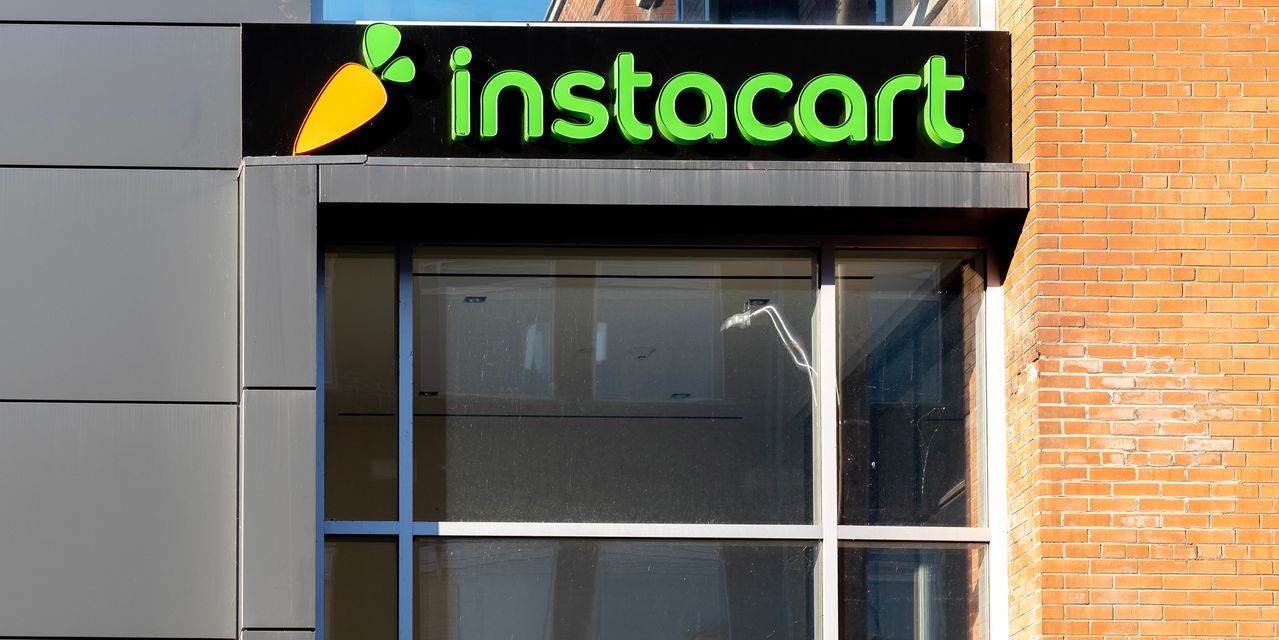Grocery-delivery app Instacart hopes to capitalize on what its chief executive calls a “massive digital transformation” in the way people shop at supermarkets, but it faces steep competition and an uncertain demand environment.
The company filed for an initial public offering late last month, and its debut could hit markets even as customers are still struggling with higher grocery prices. Meanwhile, big rivals like Walmart Inc.
WMT,
Amazon.com Inc.
AMZN,
Uber Technologies Inc.
UBER,
and DoorDash Inc.
DASH,
are competing more aggressively for a bigger slice of the online grocery-buying market, whether it’s for big weekly shopping trips or smaller runs for a handful of items.
Instacart, which would trade under the ticker CART, already controls around 22% of the $132 billion U.S. online grocery-delivery market, according to Evercore analysts. The company is banking on a bigger online future for purchases of household essentials, one that over the decades could include more mobile checkout, electronic shelf tags and what Instacart describes as “AI-powered smart carts.”
A stock-market debut for Instacart, which was founded in 2012, would come after the company last year reportedly shelved its plans to go public after decades-high inflation, recession fears and a postpandemic tech-industry slump soured investor appetites for IPOs. Last year, Instacart cut its valuation multiple times, but the company raised it this year to around $12 billion, according to the Information.
Some investors said the delay might be a good thing.
“I think they’re hitting the public markets as a more mature company that’s gone through the cost-cutting and the business-model transition behind closed doors, instead of having it play out on quarterly conference calls,” said Don Short, head of venture equity at InvestX, whose portfolio includes Instacart.
Here are five things to know about Instacart’s planned IPO.
1. It has sales growth and some profit …
During the first six months of this year, Instacart had $1.475 billion in sales, a 31% jump over the first half of last year. It closed out last year with revenue of $2.55 billion. The company finished last year with a $428 million profit, which included a hefty tax benefit, and it had net income of $242 million for the first half of this year.
Bernstein analysts, in a recent note, said the company was “more profitable than expected,” pointing to steady gross-margin expansion over the past few years. That expansion has been helped by momentum for Instacart’s advertisement business, which lets brands run sponsored ads and other promotions on Instacart. Margins also benefited from retailer and customer fees for order handling, which translated to $16 per order in 2022.
Instacart said that in 2022, the average value for a grocery order stood at $110, the Bernstein analysts noted. That year, Instacart made around $7 on average in gross profit per order.
“Overall, cohort engagement looks sticky post-Covid,” the analysts said. But they said they wondered how big the company could become, noting that 7.7 million monthly customers “isn’t a lot” and could either represent a “growth opportunity or tapping out of an audience.”
2. … but higher grocery prices have weighed on orders
Through the first six months of this year, total customer orders on Instacart stood at 132.9 million, up only slightly from the 132.3 million orders logged during the first half of last year. Instacart, in the filing, noted that higher grocery prices have weighed on demand. UBS analysts noted that customers have been ordering cheaper fare.
Short said that slower growth wasn’t surprising in light of gains made during the pandemic. And Instacart also pointed to seasonal factors that can affect demand, saying that fewer customers order on the platform during the spring and summer, with trends rebounding as the back-to-school and holiday seasons pick up.
The UBS analysts said they viewed those trends as “cautious read-throughs” for the grocery-delivery ambitions of Uber
UBER,
and DoorDash
DASH,
3. The company wants to make more money from ads, but advertisers are cautious
Like DoorDash and retailers such as Amazon.com and Walmart, Instacart hopes to use more of its digital space to allow brands to advertise. That business, for which advertisers pay fees, is growing. Instacart’s “advertising and other revenue” hit $406 million during the first half of this year — up 24% from a year ago. And digital ads elsewhere have brought fatter margins, which could help offset the costs of running a delivery network.
But Instacart noted the impact from more cautious advertiser spending amid concerns about the economy, saying “our advertising performance was impacted by changes in spend by certain brand partners due to macroeconomic uncertainty and changes in our brand partners’ businesses and performance.”
4. Its customers are big grocery chains — but its top 3 customers make up a large chunk of its sales
Instacart has partnerships with more than 1,400 retail names, including chains like Costco Wholesale Corp.
COST,
and Kroger Inc.
KR,
which wants to merge with Albertsons Cos
ACI,
Instacart, citing data from Euromonitor, noted that the top 20 grocers are responsible for more than two-thirds of the U.S. grocery market. And the grocery platform gets around 43% of its gross transaction volume — a gauge of the value of products sold — from its top three retailers.
“If any of these retailers were to suspend, limit or cease their operations or otherwise terminate their relationships with us, the attractiveness of Instacart to consumers and brands could be materially and adversely affected,” Instacart said in its IPO filing.
5. It has backing from Pepsi
In the filing, Instacart said it had entered into an agreement with PepsiCo Inc.
PEP,
under which Pepsi will buy $175 million of Instacart’s Series A redeemable convertible preferred stock in a private placement. The Series A preferred stock will have a conversion price equal to the IPO price and can be converted “under certain circumstances.”
Read the full article here













Leave a Reply